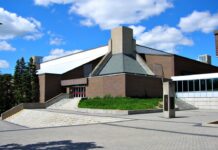MIT computer science professor Leslie Pack Kaelbling spoke at UW Feb. 5 as part of the Cheriton School of Computer Science’s Distinguished Lecture Series. As an expert in the fields of robotics and artificial intelligence, she discussed how to program robots to deal with reasoning, planning, and uncertainty.
The main challenges that arise in the creation of robots include configuring the robot to be aware of the world that they are in, programming how they will execute tasks, and finding methods that will allow the robot to deal with uncertainty.
To achieve these goals, Kaelbling has used a process called goal-regression-based planning where a task is split into its preliminary components, and these components are completed individually. Currently, robots are programmed such that they use this “back chaining” method in order to complete tasks. The planning process is recursive — meaning that it loops back to the beginning of programs and repeats — and primitive tasks are completed first in order to achieve a final condition.
Another strategy used in these robots is called a feedback loop, which allows for the robots to use a specific protocol to observe the environment before performing a task. These steps include observing, estimating, believing, planning, acting, and resetting. With this model of thinking, a robot is able to estimate the world state and approximate a model of behaviour that is appropriate for the situation. They are constantly re-evaluating, such that they can create an alternate plan when they encounter an issue or their solution does not work.
This re-evaluation process is done in the robot through something called Kalman filtering, which is a step-by-step process that is programmed within the robot, constantly taking measurements from the environment and processing them to create an estimate of unknown variables in the situation at hand.
Currently, Kaelbling’s trials have been successful, but the robots take minutes to perform tasks such as moving a chair out of the doorway because the thinking process used by the robot requires a lot of processing time. However, Kaelbling hopes for there to be technological advances that will increase the efficiency and task performance of the robots.































